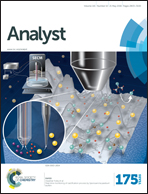A single-bead telomere sensor based on fluorescence resonance energy transfer†
Abstract
We present a 200 nm in-diameter single-bead sensor for the detection of single, unlabeled DNA molecules in solution using fluorescence resonance energy transfer technology. DNA-bound Alexa 488 and Crimson 625 loaded on commercial beads served as the donor and acceptor, respectively. Binding of the target DNA to the single bead sensor induces G-quadruplex stretching, resulting in a decrease in fluorescence energy transfer. G-rich telomere sequences formed a G-quadruplex structure in the presence of ZnTCPP, as demonstrated by the detection of two strong donor and acceptor signals. The sensitivity of the sensor was 1 fM. Under optimized conditions using a polydimethylsiloxane microfluidic device, we measured the number of sensor beads by direct counting. By controlling the flow rate via the probe volume, one sensing experiment can be completed in 5 minutes. Based on these results, we propose a new parameter—dependability (RS)—as a quantitative measure to judge the quality of a bio-sensor. This parameter is based on the ratio of the sensor and sensing sample fluorescence signals. This parameter can range from 0.1 to 100, where a value of 10 represents an optimized bio-sensor.


 Please wait while we load your content...
Please wait while we load your content...